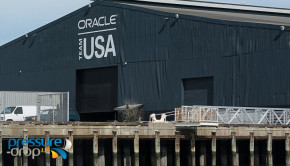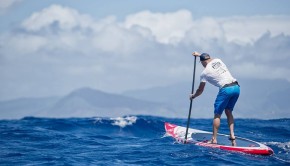Mark Reynolds – Is the Olympic men’s keelboat era over?
Published on December 5th, 2010
Olympic Sailing
 Among the ten sailing events that will be held at the 2012 Olympics, none is more senior than the men’s keelboat, and no class has been in more Olympics than the Star. But when the tentative list of events for the 2016 Olympics was voted on at the ISAF Annual Meeting last month (to be finalized in May 2011), the men’s keelboat event was gone, possibly ending a history of Olympic keelboat competition that began when sailing was included at the 1900 Games in Paris, France.
Among the ten sailing events that will be held at the 2012 Olympics, none is more senior than the men’s keelboat, and no class has been in more Olympics than the Star. But when the tentative list of events for the 2016 Olympics was voted on at the ISAF Annual Meeting last month (to be finalized in May 2011), the men’s keelboat event was gone, possibly ending a history of Olympic keelboat competition that began when sailing was included at the 1900 Games in Paris, France.
Intimately familiar with the Olympic Games is American Mark Reynolds, whose four appearances earned him a Silver and two Gold medals, with his Star accomplishments in 2000 earning him ISAF’s highest honor – World Sailor of the Year. Scuttlebutt checked in with Mark about ISAF’s decision:
Part One – Monday, December 6, 2010
Is the exclusion of the Star about how sailing now fits into the Olympic scene rather than how the Olympic events represent the sport?
The Olympic events are supposed to represent the sport. The bottom line is the IOC wants the best athletes represented in each Olympic sport. One reason baseball was dropped is that the best players were not at the Olympics. The best men sailors are currently sailing in the keelboat. Look at the entry list at the Olympics, or for last summer’s “Sail For Gold” World Cup event. The men’s keelboat athletes were undoubtedly the most accomplished. It was pointed out to me before the Annual Meeting in Athens that ISAF’s measure of the best sailor, the Rolex Sailor of the Year award, has been won 6 times in the last 11 years by sailors that are currently competing in the Star.
Some people are currently arguing that the Olympics are for the youth, and it’s better that former medalists move out of the Olympics to other challenges. For me the Olympics have always been the pinnacle of sport regardless of age, and I know my contemporaries that did leave Olympic sailing did it for nothing other than financial reasons.
Today, Olympic sailing has more financial support, enabling more at the top to stay in Olympic sailing. A keelboat class will keep the top sailors in the Olympics, either before they do the Volvo/AC or to get them back after those events. The IOC wants the Olympics to be the “pinnacle” of each sport, and a keelboat will keep the best sailors competing in the Olympics.
Mark Reynolds
 Olympic sailing began with all keelboats events. When the Star joined in 1932, it fit cleanly into that group. Now it stands alone as the only fleet racing keelboat event. Was it just a matter of time before the keelboat event was completely eliminated?
Olympic sailing began with all keelboats events. When the Star joined in 1932, it fit cleanly into that group. Now it stands alone as the only fleet racing keelboat event. Was it just a matter of time before the keelboat event was completely eliminated?
One of the seven evaluation criteria for the International Olympic Committee is “history and tradition” and so the Keelboat/Star makes a significant contribution in this area. Keelboats make up one third of the ISAF internationally-recognized classes, so this seems to be a good argument, that at least one men’s boat should be a keelboat.
Many make the mistake of thinking that the Star is what it was in the 1932 Olympics, but like other Olympic equipment it has evolved slowly over the years to become the modern boat that it is now. There’s a reason that a sailor such as Juan Kouyoumdjian, undoubtedly one of the world’s most innovative yacht designers, sails a Star and it’s not for historic reasons!
The Star is the most expensive boat of all the sailing events, and likely ranks very high among the equipment needed for any of the Olympic events. Should this matter?
Competing at the top level is expensive in every sport when considering travel, coaching, nutritionists, physio, etc. The boat is only a small part of the overall expense, and it also remains an asset with value. While the ‘out of the box’ boats may have a low initial cost, they generally are of poor quality and resale value suffers. The boat I won the Gold medal with in 2000 was the same boat I used in 1996, and this is not unusual in the Star. At the 86-boat Star World Championships last year in Europe, six of the top ten boats were between five and seven years old.
Part Two – Tuesday, December 7, 2010
When we use the word ‘athlete’, it conjures up a certain ideal, and when we say ‘Olympic athlete’ it pushes the standard up higher. Is there a perception that Star sailors do not measure up this standard?
There is little difference between the athleticism of today’s Olympic men’s keelboat sailors and any of the other sailors at the Olympics. The pure anaerobic and aerobic fitness may be a different mix. For instance, the aerobic fitness of the board sailor may be more important to winning then it is for the keelboat sailor. But just because it’s not as important, the Olympic athlete isn’t going to give up any advantage. You can put any of the top Olympic keelboat sailors on the erg next to a board sailor, and he will do just fine.
The keelboat provides the largest range of crew weights, which is the primary reason so many top sailors are drawn to the keelboat. Although the helmsman tends to be slightly smaller than the crew, this isn’t always the case. If you are small you sail with big crew and vice versa. Without the trapeze the helm and crew are virtually interchangeable.
The only limiting factor on the bottom end weight for the helmsman is having the strength to trim the large main. The range of crew weights is over two times as large as any other Olympic class. This graph from the top ten at the 2007 ISAF combined Worlds illustrates this well.
The whole argument on what is more athletic or not is a moot point. All the sailors at the Olympics are very athletic, period. Remember that those riding horses, shooting bullets or arrows, are “Olympic athletes” as well. The IOC charter states that “Olympism is a philosophy of life, exalting and combining in a balanced whole the qualities of body, will and mind.”
 When the multihull was eliminated from the 2012 Games, the multihull contingent argued that the Olympics must represent all disciplines of the sport: board sailing, multihull, singlehanded, doublehanded, and keelboat. Does this remain to be a valid argument for keeping the men’s keelboat?
When the multihull was eliminated from the 2012 Games, the multihull contingent argued that the Olympics must represent all disciplines of the sport: board sailing, multihull, singlehanded, doublehanded, and keelboat. Does this remain to be a valid argument for keeping the men’s keelboat?
Sailing is a very diverse sport, but many others are as well. In fact, the IOC encourages sports to be as diverse as possible with their “events”. However, at the end of the day the most important thing is that the best sailors have a place to compete at the Olympics. First and most important is having a boat that fits every physique, weight and height.
Part Three – Wednesday, December 8, 2010
The ISAF World Cup events have such huge entry numbers that course locations are not always ideally positioned for fair racing, and the media friendly Medal race concept encourages a course position close to shore, perhaps too close for steady winds. Are these trends better suited for dinghies than keelboats?
Pretty much any boat can sail any course; I don’t really see an issue there. I do think to encourage the best sailors in the world to continue to sail the Olympics we shouldn’t make the courses too short or sail them in substandard conditions. It’s already a difficult decision to dedicate so many years to have the chance to make the Olympic team, and to represent your country. If I knew starting out that everything could hinge on an extremely short race in super shifty conditions, I probably wouldn’t have made the commitment. I would have found other avenues to excel in the sport, as have many of my contemporaries.
The move to an inshore short course is to attract the media and interest of an audience. However, more importantly, we need to change the way the sport is presented and not the way the sport is practiced. We really haven’t put much effort yet in that area. In all my years of Olympic sailing, I had a camera on board during a race just once, (the 2000 Worlds) and my coach was dead set against it. At the Olympics, the media would show up with cameras a few days before the first race, and then discover there was no easy place to mount them. This still wasn’t solved in 2008, despite the fact that the technology is now much better.
The closest and most exciting race at the last Olympics was the medal race for the Men’s Keelboat, which I watched from the water following the Tornado medal race. GBR started ahead of SWE but was passed on the first beat, putting SWE with the points for the Gold but only by meters. GBR moved into Gold position on the first run. Each of the ten boats in the Medal race finished within fifty-five seconds, with SWE losing the silver to BRA because they got nipped by FRA by one second at the finish line!
It’s not really about the course or the boats, it’s about the presentation. Put the viewer onboard with multiple cameras; it doesn’t even have to be live, but can be quickly edited down to a 4-5 minute summery of all the action . Do this for the ten classes and you have a great sixty-minute program. Golf, a 5 hour walking game in near slow motion proves that there is a way to present it to an audience without just changing it. They don’t just follow one guy walking down the fairway to hit his ball again, they move from player to player to keep the action and competition moving along.
Of all the classes at ISAF World Cup events, the Star participates the least. Is this a factor for the Star not being selected for the 2016 Games?
The Star offers tremendous competition opportunities in its own class events. I believe more sailors will participate in the World Cup as the Olympics draws near, and as the World Cup as an entity continues to grow. The Men’s Keelboat only gets sixteen slots for the Olympics (last time 32 countries competed for those spots). Countries funding their sailors are going to make sure that they have the best chance of qualifying, before they finance them to sail around the world.
The Star fleet has always been huge in Miami, where world-class sailors are training for the winter and have other big events to sail as well. As there become more reasons to sail the World Cup, the sailors will travel to all of them. At the present there’s less motivation, so these athletes would rather stay in Miami or Garda (in Italy). The Star has class events in great venues that are very well run and organized, to the point where housing is sometimes provided. Where there is a choice to sail with over 100 boats (like last June) on the Med , or to go to Holland and Northern Germany for a smaller World Cup event, it’s not too difficult to decide which to do. When the World Cup events start having better media coverage, sponsorship, and count for qualification toward the Olympics or a World Cup final, then you will see more keelboats competing.










 We’ll keep your information safe.
We’ll keep your information safe.